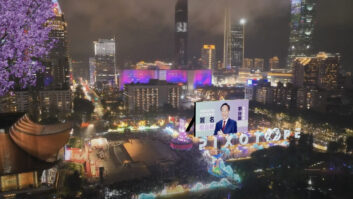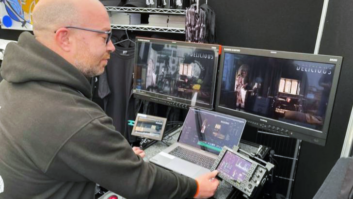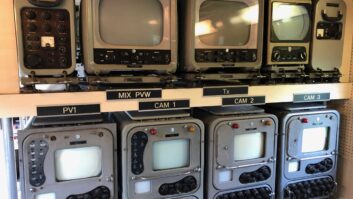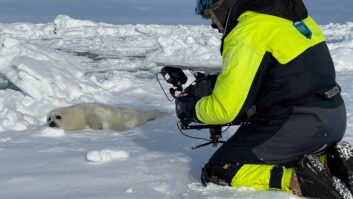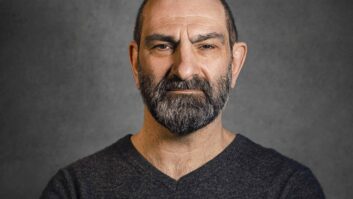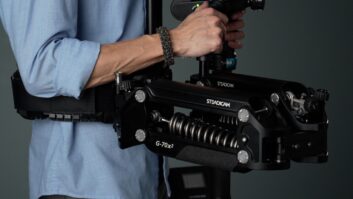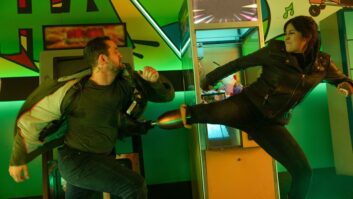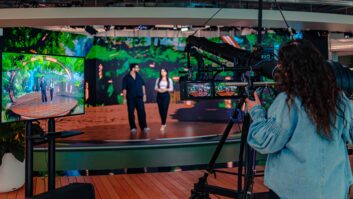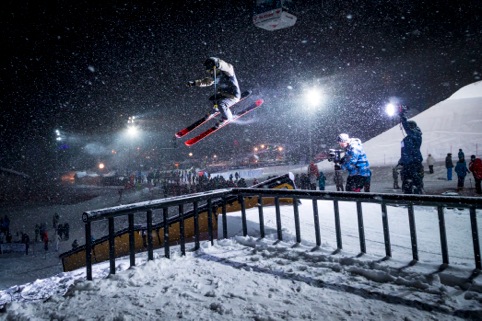
As the curtains closed on the Winter Games in Sochi, Russia, some of the biggest names in freeskiing and snowboarding were gathering in Val d’Isère, France, at the foot of Face de Bellewarde, for the 2014 Frostgun Invitational, Europe’s only platinum AFP (Association of Freeskiing Professionals) big air event. Elsie Crampton reports.
The athletes did not disappoint, putting on a display for spectators that won’t soon be forgotten. Tackling a giant custom built jump, measuring 14m in height and a massive 30m in length, skiers and boarders performed breathtaking aerial tricks and stunts. This year saw the organisers introduce a new discipline with the addition of a rail jam, The Frostgun Street Fighter.
Not just content with broadening the competition’s appeal, organisers also wanted to expand coverage of the event. Playground Production, who had worked with organisers last year to live stream the finals, bought in Thomas Yong to line up, production manage and live produce coverage of this year’s competition with the help of broadcast infrastructure from Blackmagic Design.
“I knew at the outset that our technical platform would be built around Blackmagic Design, as Playground Production had successfully streamed last year’s event on a much smaller scale using a setup featuring the ATEM 1 M/E Production Switcher and Broadcast Panel,” reveals Yong.
“This year the qualifying runs on the opening two days would be broadcast by Denmark’s DR3, TV2 in Norway and online via streaming platform adrenaline.fr, while the finals on day three were to be broadcast by Eurosport 2 and RedBull TV.”
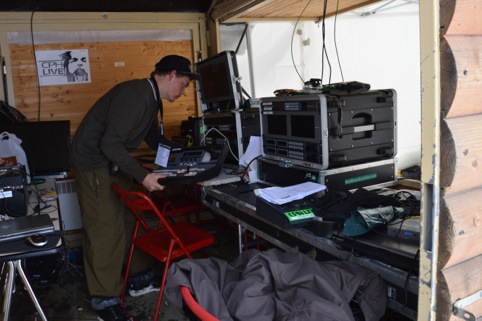
“With the help of a small technical team from CPH Live, we designed and built a multicam live production setup, complete with EVS capabilities, in just under two weeks around Blackmagic’s range of ATEM vision mixers. Getting set up wasn’t without its challenges, due to the high altitudes and getting cable runs dug in under the snow,” explained Yong.
“There were six camera positions covering the Big Air event, each one requiring a 400m optical fibre run between the camera and production switcher. At the camera end we used Blackmagic’s Mini Converter SDI to Fiber, while in the production hut we had a 1RU converter. Distances for the rail jam arena were shorter, which meant we only had to lay two optical fibre runs for our furthest two cameras and the remaining positions were connected to the switcher via a series of 100m SDI cable runs.”
With seven HD-SDI camera inputs plus an additional two inputs from a graphics playout system and a further input from an EVS system, Yong quickly realised that he was running out of inputs on the ATEM 1 M/E Production Swticher. “CPH Live had recently invested in a new ATEM 1 M/E Production Studio 4K, with 10 inputs, which we rented alongside a 16×16 Micro Videohub router allowing us to combine both vision mixers, and giving us a total of 18 SDI inputs and sufficient SDI outputs to supply various versions of the programme feed we were producing.”
Yong’s workflow also relied on three HyperDeck Studio Pro SSD broadcast decks from Blackmagic Design; one was used to record the main programme output for later offline editing, while a second unit was used as an EVS, holding intro/outro, fillers, breakers, replays and other media packets.
“A third HyperDeck Studio Pro recorded a camera feed covering the riders’ approach to the kicker (where riders take off). We could then playback the footage in super slow motion straight to the vision mixer using the time codes being noted by the operator on the second switcher to cue and replay then,” said Yong.
“We were extremely pleased with how the HyperDeck Studio Pro performed. When we were designing the solution we discussed the need for an EVS system since it offers so much production value. Unfortunately, we couldn’t find an affordable HD solution. Because of that we had to improvise and opted for three of the Blackmagic broadcast decks and paired them with two Sony FS700, capable of super slow and super slow replay.”
At the end of each day, Yong would sit down with the onset editor to create replays of key moments from the previous day’s action, which they could then play back during live transmission (TX).
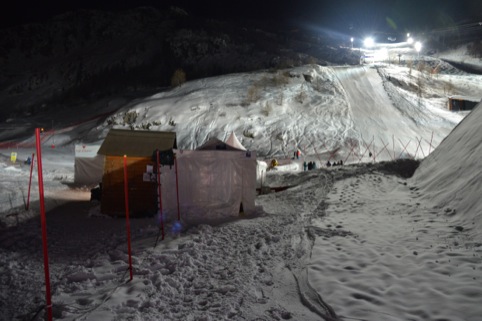
Each of the cameras had its own onboard shotgun microphone, while the sound engineer placed two microphones on stands near the kicker and the landing.
“We also had two microphones positioned in the commentators’ tent. These ran directly into a midi-mixer where the audio channels were embedded together with sound channels from a Midi-mixer through a Blackmagic Mini Converter Audio to SDI. This allowed us to split up the audio so that we had international sound (without English commentary) on channels 1+2 and English commentary on channels 3+4.”
The production team output a programme in 1080i50 to the commentator and judging positions, providing them with a live monitoring feed. The same output was also fed to an SNG van for TX while the fourth output was encoded via a Teradek Vidiu for live streaming. And lastly, the programme feed was also played out on to the venue’s various big screens, watched by more than 11,000 spectators.
